What is Cubic Zirconia? It’s The Man-Made Gemstone You Should Know!
If you’ve been looking for a diamond alternative, let’s chat about cubic zirconia. Many people are opting to replace traditional diamond engagement rings with these gems, but you still might be wondering if they are high-quality.
Where do they come from? Are they the same thing as artificial diamonds? Exactly what is cubic zirconia!?
Don’t worry. All you need to know about is right here — let’s get the low-down on how they compare to real diamonds.
Cubic Zirconia Stones: 101
Cubic zirconia jewelry is trending – but where did they come from? And, are they worth the hype?
Well, let’s get to it. Cubic zirconia is a cubic crystalline form of zirconium dioxide used as a diamond simulant by jewelers. While a natural form of zirconium oxide exists – and is extremely rare – a lab-created method of manufacturing zirconium was discovered and published in 1973. By 1976, commercial production began – and it has been the most cost-effective and popular alternative to natural diamonds ever since.
How Are They Made?
CZ stones are made by heating a mixture of zirconium oxide with calcium and magnesium at extremely high temperatures. Sometimes yttrium oxide is used in place of calcium and magnesium, resulting in a softer stone. As the mixture melts, it forms cubic zirconia crystals. These are cooled slowly so that they don’t crack.
Are They the Same as Lab-Grown Diamonds
While both artificial diamonds and CZ stones are used as diamond simulants, they are not the same thing. Lab-created diamonds can be produced using either high-temperature processes or chemical dispersions. They are made of carbon atoms, the same chemical makeup as real diamonds.
Why CZ Stones Make Perfect Conflict-Free Engagement Rings and Fine Jewelry
For a long time, diamond engagement rings were the standard – but, things are changing. Many people are shying away from natural diamonds for environmental and ethical reasons. Mining a 1-carat diamond from the earth produces a huge carbon footprint. Not to mention, illegally traded diamonds help fund violent wars in places such as Angola, Liberia, and others.
That said, people love the look of a diamond – and they want something that can replicate that look beyond just the first glance of the naked eye. They’re turning to man-made alternatives like synthetic diamonds, moissanite, and cubic zirconia.
Cubic zirconia engagement rings, necklaces, and earrings are becoming especially popular – and for good reason. From their appearance to their cost, everything about them makes them a perfect gift for Valentine’s Day, an anniversary, or just for fun.
Hardness and Durability
It’s true that nothing beats a diamond in terms of durability. They rate at a 10 on the Mohs hardness scale.
But, cubic zirconia isn’t that far behind! They rate an 8.5 on the Mohs hardness scale, which is harder than other popular gemstones. Emeralds and topaz rate between 7.5 to an 8. The only other stones that beat cubic zirconia in terms of hardness are rubies and sapphires, which rate at a 9.
Appearance and Luster
To the untrained eye, it’s hard to tell the difference between a cubic zirconia and a real diamond. Gemologists can identify the difference, but it takes a close inspection. CZ stones have a slightly different tint than natural diamonds (which can have a yellow or brown tint whereas cubic zirconia is completely colorless).
While the refractive index of diamonds is slightly higher than cubic zirconia, CZ stones do have a higher refractive index than most gemstones. Also, real diamonds typically throw off a white light when they shine, but CZ stones spark with reds, yellows, and blues – which makes them especially attractive against a nice, sterling silver band.
Since cubic zirconia stones are man-made, they come without any inclusions or blemishes. Their clarity is even more beautiful and precise than that of a natural diamond since they’re made in a controlled environment.
Cost
A CZ stone is much more affordable than a natural diamond. 1-carat diamonds typically cost $1800, whereas a 1-carat CZ stone could cost $20. They’re even more affordable than other diamond simulants. Artificial diamonds tend to cost around $1200, and moissanite around $80 for 1-carat stones.
Drawbacks
The financial accessibility of cubic zirconia is seen as a drawback by those who are attracted to gemstones for their exclusivity – but that’s a silly concern considering the perfect beauty of the stone.
It’s true that cubic zirconia doesn’t last as long as a natural diamond, because while it’s extremely tough, it can take on damage over the years. Lower grades can cloud. However, with the proper care, and at least an AAA-grade stone, your piece of jewelry can last a long, long time.
How to Care For Your Cubic Zirconia
When it comes to taking care of your cubic zirconia, you want to clean it at least once a month – ideally, every two weeks is best. To do so, use a non-abrasive cloth or soft bristle brush. A baby’s toothbrush also works wonders. Use a mild soap, free of chemicals, and warm water to wash your cubic zirconia jewelry. Gentle dishwashing soap works well.
Don’t wear it while bathing, swimming, or exercising. When not wearing your jewelry, keep it in a clean, dry place. Keep individual pieces of jewelry in their own separate pouches to avoid tangles and scratches.
Treat Yourself to Some Sparkle
Well – now you know all about cubic zirconia!
And now that you do, we bet you’re dying to get your hands on some trendy jewelry featuring CZ stones.
You’re in the right place! We carry pieces featuring natural gemstones as well as stunning white and aquamarine zirconia. Shop our online store today and find yourself a piece (or two) that you adore.





